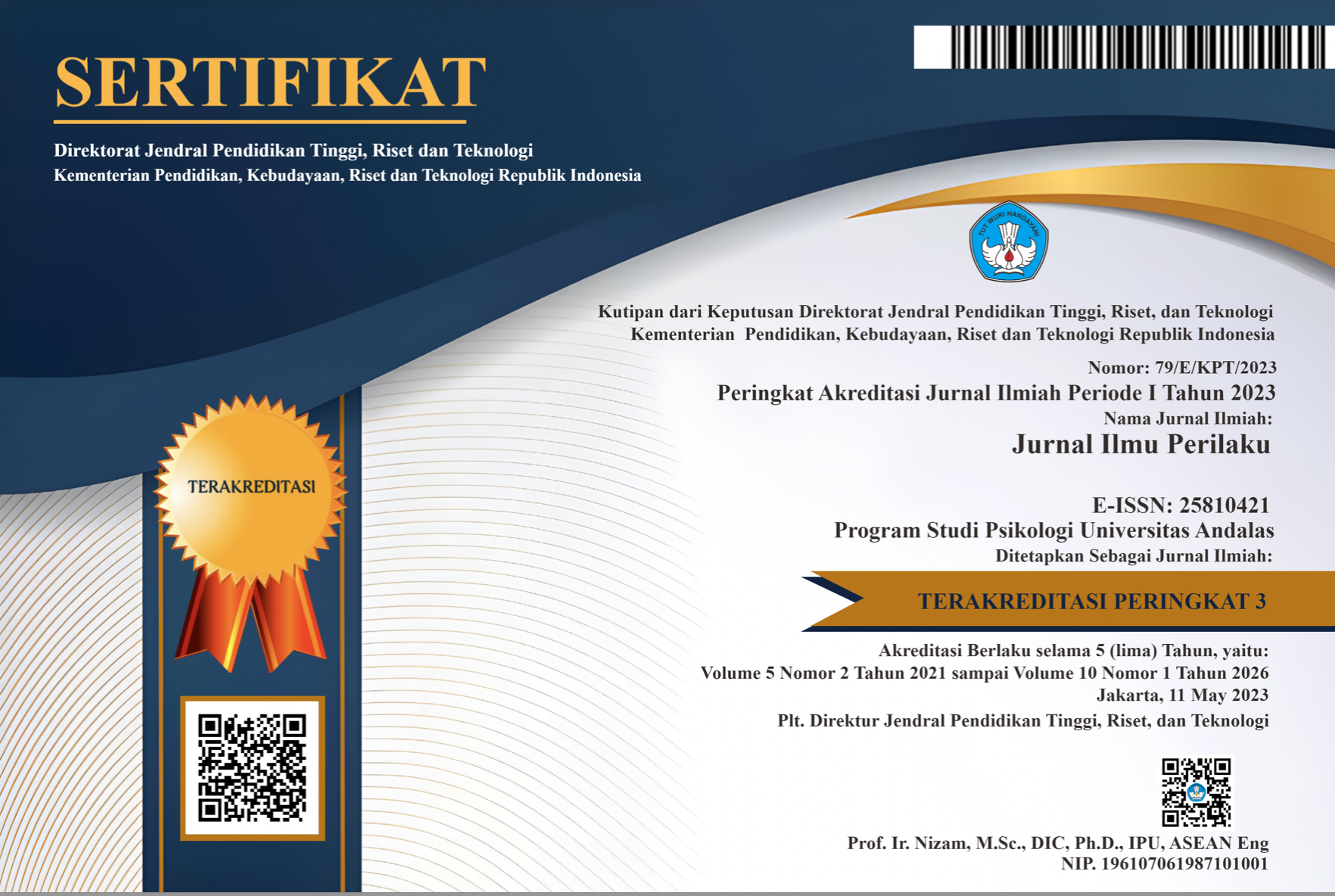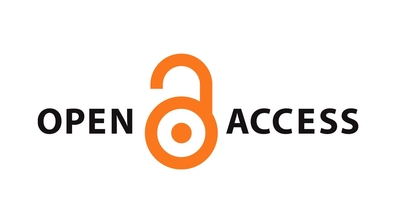Bullying pada Remaja: Pentingkah Keberfungsian Keluarga, Kebahagiaan di Sekolah, dan Self-Esteem?
A CORRELATION STUDY AMONG ADOLESCENT
Abstract
Abstract. Bullying has become one of the most common violent behaviors among adolescents worldwide. The current study examined the relationship between family functioning, happiness at school, and self-esteem with bullying among adolescents. A total of 121 adolescents (45 males and 76 females) aged between 12 – 15 years were recruited through simple random sampling. The measuring instruments were the Family Functioning in Adolescence Questionnaire (FFAQ), School Children’s Happiness Inventory (SCHI), Self-Esteem Scale (SSC), and Multidimensional Peer Victimization Scale (MPVS). Data were analyzed with multiple correlation techniques. The results showed that family functioning, happiness at school, and self-esteem were simultaneously correlated with bullying with negative direction. These findings have shown the importance of the roles of family and school to prevent bullying acts among adolescents.
Downloads
References
Azwar, S. (2017). Metode Penelitian Psikologi (Second Edition). Yogyakarta: Pustaka Pelajar.
Bibou-Nakou, I., Tsiantis, J., Assimopoulos, H., & Chatzilambou, P. (2013). Bullying/victimization from a family perspective: a qualitative study of secondary school students’ views. European Journal of Psychology of Education, 28(1), 53–71. https://doi.org/10.1007/s10212-011-0101-6.
Chalmers, C., Campbell, M. A., Spears, B. A., Butler, D., Cross, D., Slee, P., & Kift, S. (2016). School policies on bullying and cyberbullying: perspectives across three Australian states. Educational Research, 58(1), 91–109. https://doi.org/10.1080/00131881.2015.1129114.
Cosma, A., Whitehead, R., Neville, F., Currie, D., & Inchley, J. (2017). Trends in bullying victimization in Scottish adolescents 1994–2014: changing associations with mental well-being. International Journal of Public Health, 62(6), 639–646. https://doi.org/10.1007/s00038-017-0965-6.
Erginoz, E., Alikasifoglu, M., Ercan, O., Uysal, O., Alp, Z., Ocak, S., Oktay Tanyildiz, G., Ekici, B., Yucel, I. K., & Albayrak Kaymak, D. (2015). The Role of Parental, School, and Peer Factors in Adolescent Bullying Involvement. Asia Pacific Journal of Public Health, 27(2), NP1591–NP1603. https://doi.org/10.1177/1010539512473144.
Eriksen, I. M. (2018). The power of the word: students’ and school staff’s use of the established bullying definition. Educational Research, 60(2), 157–170. https://doi.org/10.1080/00131881.2018.1454263.
Fandrem, H., & Støen, J. (2021). Immigrant and Non-immigrant Parents’ Involvement in Bullying Cases. International Journal of Bullying Prevention. https://doi.org/10.1007/s42380-021-00106-6.
Fanti, K. A., & Henrich, C. C. (2015). Effects of Self-Esteem and Narcissism on Bullying and Victimization During Early Adolescence. The Journal of Early Adolescence, 35(1), 5–29. https://doi.org/10.1177/0272431613519498.
Farrell, A. H., Schiralli, K. N., & Volk, A. A. (2017). Factors That Influence Bullying. In Encyclopedia of Evolutionary Psychological Science (pp. 1–5). Springer International Publishing. https://doi.org/10.1007/978-3-319-16999-6_162-1.
Flouri, E., & Buchanan, A. (2003). The Role of Mother Involvement and Father Involvement in Adolescent Bullying Behavior. Journal of Interpersonal Violence, 18(6), 634–644. https://doi.org/10.1177/0886260503251129.
Iswinarti, & Khairunnisa, H. (2021). Enhancing self-esteem using child-centred play therapy on bullying victims children. AMCA Journal of Education and Behavioral Change, 1(2), 37–43. https://doi.org/10.51773/ajeb.v1i2.97.
Ivens, J. (2007). The Development of a Happiness Measure for Schoolchildren. Educational Psychology in Practice, 23(3), 221–239. https://doi.org/10.1080/02667360701507301.
Katsaras, G. N., Vouloumanou, E. K., Kourlaba, G., Kyritsi, E., Evagelou, E., & Bakoula, C. (2018). Bullying and Suicidality in Children and Adolescents Without Predisposing Factors: A Systematic Review and Meta-analysis. Adolescent Research Review, 3(2), 193–217. https://doi.org/10.1007/s40894-018-0081-8.
Lereya, S. T., Copeland, W. E., Costello, E. J., & Wolke, D. (2015). Adult mental health consequences of peer bullying and maltreatment in childhood: two cohorts in two countries. The Lancet Psychiatry, 2(6), 524–531. https://doi.org/10.1016/S2215-0366(15)00165-0.
Mazzone, A., & Camodeca, M. (2019). Bullying and Moral Disengagement in Early Adolescence: Do Personality and Family Functioning Matter? Journal of Child and Family Studies, 28(8), 2120–2130. https://doi.org/10.1007/s10826-019-01431-7.
Mongrain, M., Chin, J. M., & Shapira, L. B. (2011). Practicing Compassion Increases Happiness and Self-Esteem. Journal of Happiness Studies, 12(6), 963–981. https://doi.org/10.1007/s10902-010-9239-1.
Monks, C. P., & O’Toole, S. (2021). Bullying in Preschool and Infant School. In The Wiley Blackwell Handbook of Bullying (pp. 2–19). Wiley. https://doi.org/10.1002/9781118482650.ch35.
Muliani, H., & Pereira, R. (2018). Why Children Bully? Jakarta: Grasindo.
Murphy, T. P., Laible, D., & Augustine, M. (2017). The Influences of Parent and Peer Attachment on Bullying. Journal of Child and Family Studies, 26(5), 1388–1397. https://doi.org/10.1007/s10826-017-0663-2.
Mynard, H., & Joseph, S. (2000). Development of the multidimensional peer-victimization scale. Aggressive Behavior, 26(2), 169–178. https://doi.org/10.1002/(SICI)1098-2337(2000)26:2<169::AID-AB3>3.0.CO;2-A.
Navarro, R., Ruiz-Oliva, R., Larrañaga, E., & Yubero, S. (2015). The Impact of Cyberbullying and Social Bullying on Optimism, Global and School-Related Happiness and Life Satisfaction Among 10-12-year-old Schoolchildren. Applied Research in Quality of Life, 10(1), 15–36. https://doi.org/10.1007/s11482-013-9292-0.
OECD. (2017). PISA 2015 Results (Volume III): Students’ Well-Being. Paris: OECD Publishing. https://doi.org/10.1787/9789264273856-en.
OECD. (2018). Teaching for the Future: Effective Classroom Practices to Transform Education. Paris: OECD Publishing. https://doi.org/10.1787/9789264293243-en.
Pratiwi, M. P., Fitriani, N., & Setiyadi, I. (2021). Hubungan kejadian bullying dengan self-esteem (harga diri) dan resiliensi pada remaja . Alauddin Scientific Journal of Nursing, 2(1), 10–18.
Rigby, K. (2013). Bullying in schools and its relation to parenting and family life. Family Matters, (92), 61–67.
Rigby, K., & Smith, P. K. (2011). Is school bullying really on the rise? Social Psychology of Education, 14(4), 441–455. https://doi.org/10.1007/s11218-011-9158-y.
Roelofse, R., & Middleton, M. R. (1985). The family functioning in adolescence questionnaire: a measure of psychosocial family health during adolescence. Journal of Adolescence, 8(1), 33–45. https://doi.org/10.1016/S0140-1971(85)80005-1.
Rosenberg, M. (1965). Society and the Adolescent Self-Image. Princeton University Press. https://doi.org/10.1515/9781400876136.
Smith, P. K. (2014). Understanding School Bullying: Its Nature & Prevention Strategies. SAGE Publications, Inc. https://doi.org/10.4135/9781473906853.
Tambelli, R., Laghi, F., Odorisio, F., & Notari, V. (2012). Attachment relationships and Internalizing and Externalizing problems among Italian adolescents. Children and Youth Services Review, 34(8), 1465–1471. https://doi.org/10.1016/j.childyouth.2012.04.004.
Tandiono, I. M., Soetikno, N., & Dewi, F. I. R. (2020). Descriptive Study of the Family Functioning in Adolescent Victims of Bullying. Proceedings of the 2nd Tarumanagara International Conference on the Applications of Social Sciences and Humanities (TICASH 2020). https://doi.org/10.2991/assehr.k.201209.091.
Tsaousis, I. (2016). The relationship of self-esteem to bullying perpetration and peer victimization among schoolchildren and adolescents: A meta-analytic review. Aggression and Violent Behavior, 31, 186–199. https://doi.org/10.1016/j.avb.2016.09.005.
Tsitsika, A. K., Barlou, E., Andrie, E., Dimitropoulou, C., Tzavela, E. C., Janikian, M., & Tsolia, M. (2014). Bullying Behaviors in Children and Adolescents: “An Ongoing Story.” Frontiers in Public Health, 2, 1–4. https://doi.org/10.3389/fpubh.2014.00007.
Uusitalo-Malmivaara, L. (2012). Global and School-Related Happiness in Finnish Children. Journal of Happiness Studies, 13(4), 601–619. https://doi.org/10.1007/s10902-011-9282-6.
Uusitalo-Malmivaara, L., & Lehto, J. E. (2016). Happiness and depression in the traditionally bullied and cyberbullied 12-year-old. Open Review of Educational Research, 3(1), 35–51. https://doi.org/10.1080/23265507.2016.1155168.
Vásquez, N. S., Zuluaga, N. C., & Fernández, D. Y. (2017). School Climate and Family Functionality as Associated Factors to Bullying in Students of Antioquia, Colombia. Pensamiento Psicológico, 15(1), 63–72.
Veenhoven, R. (2010). How Universal Is Happiness? In E. Diener, J. F. Helliwell, & D. Kahneman (Eds.), International Differences in Well-Being (pp. 328–350). Oxford University Press. https://doi.org/10.1093/acprof:oso/9780199732739.003.0011.
Veenhoven, R. (2015). Informed Pursuit of Happiness: What we should know, do know and can get to know. Journal of Happiness Studies, 16(4), 1035–1071. https://doi.org/10.1007/s10902-014-9560-1.
Wolke, D., Copeland, W. E., Angold, A., & Costello, E. J. (2013). Impact of Bullying in Childhood on Adult Health, Wealth, Crime, and Social Outcomes. Psychological Science, 24(10), 1958–1970. https://doi.org/10.1177/0956797613481608.
Yang, A., & Salmivalli, C. (2015). Effectiveness of the KiVa antibullying programme on bully-victims, bullies and victims. Educational Research, 57(1), 80–90. https://doi.org/10.1080/00131881.2014.983724.
Zhong, M., Huang, X., Huebner, E. S., & Tian, L. (2021). Association between bullying victimization and depressive symptoms in children: The mediating role of self-esteem. Journal of Affective Disorders, 294, 322–328. https://doi.org/10.1016/j.jad.2021.07.016.

This work is licensed under a Creative Commons Attribution-NonCommercial-ShareAlike 4.0 International License.
The non-commercial use of the article is governed by the Creative Commons Attribution license as currently displayed on Creative Commons Attribution-NonCommercial-ShareAlike 4.0 International License.
JIP's spirit is to disseminate articles published are as free as possible. Under the Creative Commons license, JIP permits users to copy, distribute, display, and perform the work for non-commercial purposes only. Users will also need to attribute authors and JIP on distributing works in the journal.
Please find the rights and licenses in Jurnal Ilmu Perilaku (JIP).
- License
The non-commercial use of the article will be governed by the Creative Commons Attribution license as currently displayed on Creative Commons Attribution-NonCommercial-ShareAlike 4.0 International License.
- Author’s Warranties
The author warrants that the article is original, written by stated author(s), has not been published before, contains no unlawful statements, does not infringe the rights of others, is subject to copyright that is vested exclusively in the author and free of any third party rights, and that any necessary written permissions to quote from other sources have been obtained by the author(s).
- User Rights
JIP's spirit is to disseminate articles published are as free as possible. Under the Creative Commons license, JIP permits users to copy, distribute, display, and perform the work for non-commercial purposes only. Users will also need to attribute authors and JIP on distributing works in the journal.
- Rights of Authors
Authors retain the following rights:
- Copyright, and other proprietary rights relating to the article, such as patent rights,
- The right to use the substance of the article in future own works, including lectures and books,
- The right to reproduce the article for own purposes, provided the copies are not offered for sale,
- The right to self-archive the article.
- Co-Authorship
If the article was jointly prepared by other authors, the signatory of this form warrants that he/she has been authorized by all co-authors to sign this agreement on their behalf, and agrees to inform his/her co-authors of the terms of this agreement.
- Termination
This agreement can be terminated by the author or JIP upon two months’ notice where the other party has materially breached this agreement and failed to remedy such breach within a month of being given the terminating party’s notice requesting such breach to be remedied. No breach or violation of this agreement will cause this agreement or any license granted in it to terminate automatically or affect the definition of JIP.
- Royalties
This agreement entitles the author to no royalties or other fees. To such extent as legally permissible, the author waives his or her right to collect royalties relative to the article in respect of any use of the article by JIP or its sublicensee.
- Miscellaneous
JIP will publish the article (or have it published) in the journal if the article’s editorial process is successfully completed and JIP or its sublicensee has become obligated to have the article published. JIP may conform the article to a style of punctuation, spelling, capitalization, referencing and usage that it deems appropriate. The author acknowledges that the article may be published so that it will be publicly accessible and such access will be free of charge for the readers.










